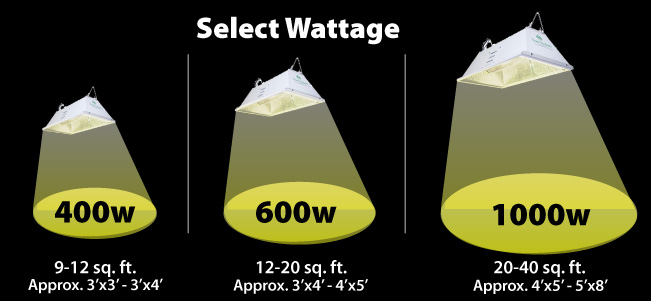.
To correctly determine the best lighting for your space there are several things that you have to know. At this point, a couple of definitions are in order.
Lumens – one lumen is equal to the amount of light emitted by one candle that falls on one square foot of surface one foot away.
Measure your light with a light meter: Click here
Watts – A measure of the amount of electricity flowing through a wire. Watt hours measure the amount of watts used in one hour. A kilowatt/hour (KWH) is 1000 watt/hours.
Light Size Estimates:
2 x 2 [4 sq ft] – 150 or 250 watts
2 x 3 [6 sq ft ] – 250 watts
3 x 3 [9 sq ft] – 450 (400 or 600 watt)
4 x 4 [16 sq ft] – 800 watts (600 or 1000 watt)
4 x 6 [24 sq ft] – 1200 watts (2 – 600w)
5 x 5 [25 sq ft] – 1250 watts (2 – 600w or 1 – 1000w)
4 x 8 [32 sq ft] – 1600 watts (3 – 600w or 2 – 1000w)
Measure your light with a light meter: Click here
How to determine how much light you need in watts:
The general rule of thumb for providing light for an area is a minimum of 30 watts per square foot. 50 watts per square foot is optimal. You can determine the proper lighting for your area by using this formula: 30 watts (or 50) x ?(your) square feet. Example: You have an area of 10 sq. ft. – 30w x 10 s.f. = 300watts/sq.ft minimum or 50 watts x 10 s.f. = 500 watts/sq. ft. (optimal). Also, remember that fluorescent’s are weaker and emit less light than an HID. This means you will need 5 times the amount of wattage to equal the output of an HID. So, 30 watts of HID would equal 150 watts of fluorescent’s. This is why it is advised to provide a minimum of 30 watts per square foot for HID lights and a minimum of 150 watts per square foot for fluorescent’s.
To determine the cost of operating your light:
Find your KWH charge on your electric bill. Assume you have a 1000 watt light and your KWH charge is $.05/hour. A kilowatt equals 1000 watts, therefore it will cost you .05 cents per hour to run that light. Here’s another example. Say you have a 400 watt light and your KWH charge is $.03. Since 400 watts is not a kilowatt, you must divide 400 by 1000 = .4 kilowatts x .03 (KWH rate from electric bill) = $0.012 cents per hour to run.
Conclusion:
This is all important because the light intensity will directly affect the quality and yield of your crop. If you have less than optimal lighting your yield and potency will be reduced and buds will not develop as dense. This point can not be stressed enough. You must have the right amount of light for your space to grow high quality bud. The question is often asked, “can I have too MUCH light?”. The basic answer is no. According to the law of diminishing returns, you could theoretically reach a point when your plants just couldn’t absorb any more light but it would be impossible to have that many lights in your space. Heat from the lights would become a problem long before you ever reached that point. So use as many lights as you want, just control the heat.Experimentation is the only sure method to determine the best solution for each plant. If plants are not receiving enough light, they begin to grow tall and spindly as if stretching for the light and foliage becomes pale green. Or, if they need to be moved closer to the light, or given a longer light exposure period. Too much light may lead to bleaching of leaves and flowers, browning and shriveling. Leaves would become overly compact and curl under at the edges.

